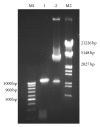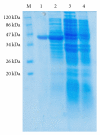Expression of a Gene Encoding 34.9 kDa PPE Antigen of Mycobacterium avium subsp. paratuberculosis in E. coli
- PMID: 22110958
- PMCID: PMC3218304
- DOI: 10.4061/2010/628153
Expression of a Gene Encoding 34.9 kDa PPE Antigen of Mycobacterium avium subsp. paratuberculosis in E. coli
Abstract
Mycobacterium avium subsp. paratuberculosis (Map) contains PPE family antigens which are Proline and glutamic acid rich and may play important role as T cell antigens. Hence the identification and generation of antigens are necessary for immunological characterization. In the present study, the epitopic region of a unique PPE gene encoding 34.9 kDa protein from Map was amplified by polymerase chain reaction. The gene was cloned into Escherichia coli vector pQE30 UA. The recombinant plasmid designated as pQPPE was transformed into E. coli M15 and induced with IPTG revealed the high level expression of 37.1 kDa His-fusion protein (34.9 kDa PPE and 2.2 kDa His-tag), which was confirmed by immunoblotting. Recombinant PPE protein was then purified by Ni-NTA agarose chromatography. The polyclonal antiserum raised against purified recombinant PPE protein reacted with expressed 37.1 kDa His-fusion protein as well as with Map sonicate. The protein elicited significant delayed type hypersensitivity (DTH) skin reaction in mice sensitized with Map. The results indicated that the recombinant PPE protein of Map was associated with cellular immune response.
Figures




Similar articles
-
Coexpression of PPE 34.9 Antigen of Mycobacterium avium subsp. Paratuberculosis with Murine Interferon Gamma in HeLa Cell Line and Study of Their Immunogenicity in Murine Model.Biotechnol Res Int. 2011 Feb 10;2011:632705. doi: 10.4061/2011/632705. Biotechnol Res Int. 2011. PMID: 21350664 Free PMC article.
-
Expression and purification of a gene encoding a 9.7 kDa PE protein of Mycobacterium avium subsp. paratuberculosis.3 Biotech. 2016 Dec;6(2):198. doi: 10.1007/s13205-016-0506-7. Epub 2016 Sep 15. 3 Biotech. 2016. PMID: 28330270 Free PMC article.
-
Recombinant 20.8-kDa protein of Mycobacterium avium subsp. paratuberculosis-based sero-diagnosis of paratuberculosis.3 Biotech. 2017 Jul;7(3):156. doi: 10.1007/s13205-017-0758-x. Epub 2017 Jun 16. 3 Biotech. 2017. PMID: 28623492 Free PMC article.
-
Heterologous expression of a gene encoding a 35 kDa protein of Mycobacterium avium paratuberculosis in Escherichia coli.Vet Res Commun. 2004 Apr;28(3):209-24. doi: 10.1023/b:verc.0000017371.68083.04. Vet Res Commun. 2004. PMID: 15074767
-
A specific induction of interleukin-10 by the Map41 recombinant PPE antigen of Mycobacterium avium subsp. paratuberculosis.Vet Immunol Immunopathol. 2010 May 15;135(1-2):71-78. doi: 10.1016/j.vetimm.2009.11.002. Epub 2009 Nov 13. Vet Immunol Immunopathol. 2010. PMID: 20018382
Cited by
-
Coexpression of PPE 34.9 Antigen of Mycobacterium avium subsp. Paratuberculosis with Murine Interferon Gamma in HeLa Cell Line and Study of Their Immunogenicity in Murine Model.Biotechnol Res Int. 2011 Feb 10;2011:632705. doi: 10.4061/2011/632705. Biotechnol Res Int. 2011. PMID: 21350664 Free PMC article.
-
The alphabet of intrinsic disorder: II. Various roles of glutamic acid in ordered and intrinsically disordered proteins.Intrinsically Disord Proteins. 2013 Apr 1;1(1):e24684. doi: 10.4161/idp.24684. eCollection 2013 Jan-Dec. Intrinsically Disord Proteins. 2013. PMID: 28516010 Free PMC article. Review.
-
Expression and purification of a gene encoding a 9.7 kDa PE protein of Mycobacterium avium subsp. paratuberculosis.3 Biotech. 2016 Dec;6(2):198. doi: 10.1007/s13205-016-0506-7. Epub 2016 Sep 15. 3 Biotech. 2016. PMID: 28330270 Free PMC article.
-
Recombinant 20.8-kDa protein of Mycobacterium avium subsp. paratuberculosis-based sero-diagnosis of paratuberculosis.3 Biotech. 2017 Jul;7(3):156. doi: 10.1007/s13205-017-0758-x. Epub 2017 Jun 16. 3 Biotech. 2017. PMID: 28623492 Free PMC article.
-
Comparative genomics between human and animal associated subspecies of the Mycobacterium avium complex: a basis for pathogenicity.BMC Genomics. 2015 Sep 15;16(1):695. doi: 10.1186/s12864-015-1889-2. BMC Genomics. 2015. PMID: 26370227 Free PMC article.
References
-
- Sweeney RW, Jones DE, Habecker P, Scott P. Interferon-γ and interleukin 4 gene expression in cows infected with Mycobacterium paratuberculosis . American Journal of Veterinary Research. 1998;59(7):842–847. - PubMed
-
- Sechi LA, Scanu AM, Molicotti P, et al. Detection and isolation of Mycobacterium avium subsp. paratuberculosis from intestinal mucosal biopsies of patients with and without Crohn’s disease. American Journal of Gastroenterology. 2005;100(7):1529–1536. - PubMed
-
- Naser SA, Ghobrial G, Romero C, Valentine JF. Culture of Mycobacterium avium subspecies paratuberculosis from the blood of patients with Crohn’s disease. Lancet. 2004;364(9439):1039–1044. - PubMed
LinkOut - more resources
Full Text Sources
